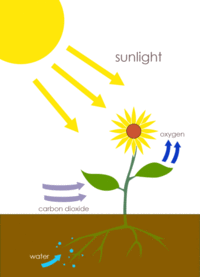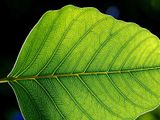Topic in Gardening courses
Photosynthesis is the process by which green plants and some other organisms use sunlight to synthesize foods from carbon dioxide and water. It is the magical process that makes all our gardening and farming worthwhile. Air (carbondioxide) and water and sunlight are transformed into energy (sugar) and the structural element (carbon) for cells and oxygen to breathe.
Photosynthesis is vital for all life on Earth that needs oxygen.
- Photosynthesis maintains normal levels of oxygen in the atmosphere
- It is the source of energy for building up the cells of an organism in which photosynthesis occurs, or as a source of food, it gives this energy to other organisms. For example, humans and animals eat plants.
The exception are some organisms such as bacteria that live in hostile environments such as deep sea vents.[1]
Chemical reaction of photosynthesis
- Carbon dioxide (chemical formula CO2) is a naturally occurring chemical compound composed of two oxygen atoms covalently bonded to a single carbon atom. It is a gas at standard temperature and pressure and exists in Earth's atmosphere in this state, as a trace gas at a concentration of 0.039% by volume.[2]
- Water is a chemical substance with the chemical formula H2O. A water molecule contains one oxygen and two hydrogen atoms. Water is a liquid at ambient conditions, but it often co-exists on Earth with its solid state, ice, and gaseous state (water vapor or steam).[3]
- Sugar is a class of edible crystalline carbohydrates[4], mainly sucrose, lactose, and fructose, characterized by a sweet flavor. Sucrose in its refined form primarily comes from sugar cane and sugar beet.[5]
- Oxygen is the element with atomic number 8 and represented by the symbol O.[6]
Video
Photosynthesis A somewhat technical explanation, but it gives you an idea of the complex reactions involved in photosynthesis - Mr. Andersen explains how plants create food through the process of photosynthesis. Both the light reaction and the Calvin Cycle are explained. A brief discussion of chlorophyll is also included.
Gallery
See also
References
External links
- Photosynthesis Wikipedia




